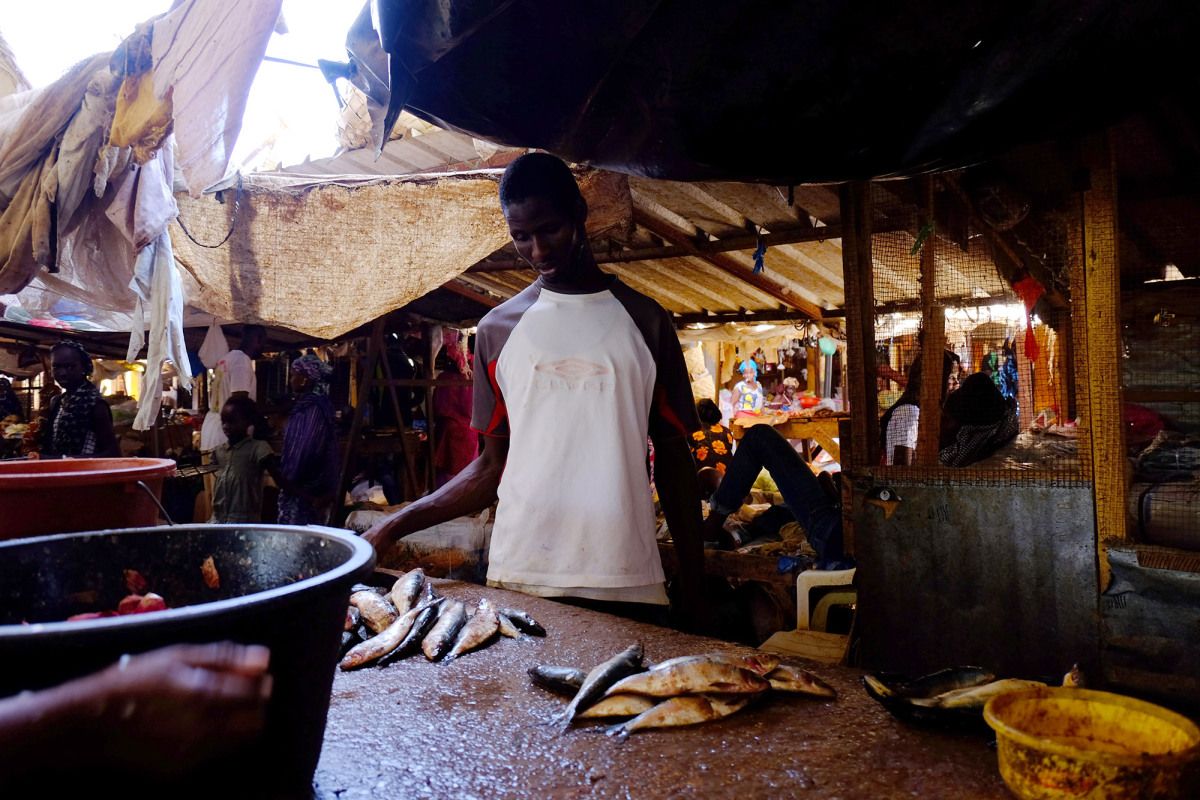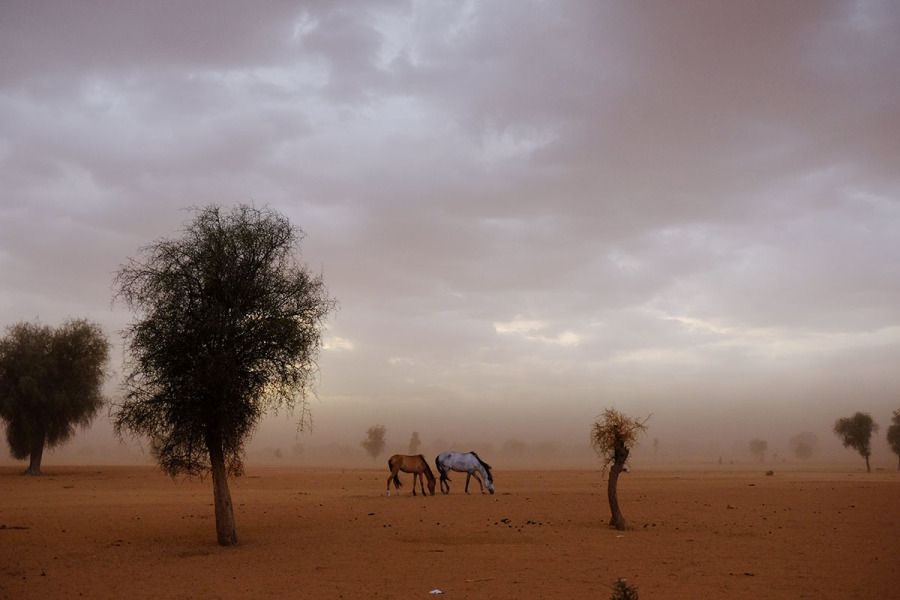DAHRA, Senegal — In his stall in the middle of a bustling covered market, a low ceiling blocking out the unforgiving sun, Mohammad Moustafa Ndoye plucks damp fish after damp fish out of a plastic bucket and plunks them onto a concrete slab. With an old knife, he sloughs off their silver scales, some of them sticking, glittering, to his hands and forearms. He turns his heavy-lidded eyes to the left and to the right, but, so far, there are no buyers, which means no money to bring home for his wife and their two children, nothing to replace the savings he wiped out last April — 2 million CFA, or about $3,600 — all of it for nothing.
Mohammad Moustafa Ndoye is not supposed to be here.
If you had asked him last year where he would be now — before the long bus trip and the smugglers and the desert and the Mediterranean, before prison and his first ride in an airplane, before the humiliation of coming back here to Dahra, a Senegalese city about 150 miles inland from Dakar, the capital — he would have said: in Italy. Making plenty of money, at least relative to his income in Senegal. Finding opportunity, even without an official work permit or legal residency, just like the tens of thousands of other men from Senegal who migrate to Europe every year. They send back the money that pays for the concrete houses that stand out in villages of thatched huts. They have a future.
But not Ndoye. Here in the fish market, where his hopes have been replaced by humiliation, the future looks like more of the same: scaling, selling, and, too often, not selling. On a good day, Ndoye now makes 4,000 CFA, or about $7. He would make more if he could buy a refrigerated truck to transport fresh fish directly from the coast, but that would cost roughly $9,000, an amount that would take him a decade or more to save in Senegal. Just a few years in Europe, though, and he would earn easily that much.
Which is why, in April, Ndoye used the money he saved up to buy a bus ticket to Mali and another to Burkina Faso and finally one to Agadez, a notorious smuggling hub in Niger located at the gateway to the Sahara. There he paid a smuggler about $270 for a seat in a pickup truck packed with 24 other men, one in a convoy of a dozen similar trucks overflowing with travelers bound for Libya. They were packed so tightly that when the trucks occasionally jolted over rocks or dunes, men would sometimes fall off into the desert; the convoy wouldn’t stop. “You don’t sleep,” Ndoye recalled. “When you sleep, you fall and you die.”
Once he reached Libya’s Mediterranean coast, smugglers herded Ndoye onto a flimsy rubber dingy with more than 100 other migrants. They didn’t make it far before the engine failed. Libyan authorities eventually hauled them ashore and threw them all in prison, promising to release them if they paid a hefty ransom. Ndoye’s family sent money for his release, but the guards at the prison didn’t hold up their end of the bargain. For 13 days, he and the other rescued migrants stayed locked in a 40-square-foot room, given so little food that “we got thinner and thinner,” he said.
Eventually, one of the prison guards appeared to take pity on him. He invited Ndoye over to his house, fed him, and shook him down for more money, which his sister wired from Senegal. When he was finally set free, he went straight to the Senegalese Embassy in Tripoli, where he paid another $400 for a plane ticket to Niger. Then he took the bus trip in reverse — first to Mali, then back to Dakar, and then back here, back to selling fish.
Last year, more than 10,000 Senegalese migrants made it to Italian shores via the Mediterranean Sea. They were among 181,000 mostly sub-Saharan African migrants who took what experts call the “Central Mediterranean route” to Europe from North Africa. An estimated 400,000 migrants are currently stranded in Libya, many of them in detention facilities supported by the International Organization for Migration. The men in these detention centers are routinely beaten, extorted for money, and sometimes sold into forced labor; women are often sold for sex.
“At IOM, we promote migration,” said Jo-Lind Roberts, IOM’s head of office in Senegal. “But in the issue with the Mediterranean migration route, we can’t keep going like this.”
Migrants who fail to reach Europe often return home reluctantly, embarrassed to see their plans thwarted and money lost or their role as a family breadwinner diminished. Even worse is admitting they were jailed, as if they were criminals — an experience that carries a heavy stigma in some villages. Many returnees are traumatized by the deaths they witnessed and the abuses they saw around them, but few receive psychological care. According to Roberts, IOM encourages them to talk to their families and neighbors about the hardships of the journey, both for catharsis and to discourage others from taking the perilous trip. Firsthand stories, she said, challenge a widespread “vision of Europe or the trip, which doesn’t correspond with reality.”
Malik Diop was one of those with an unrealistic view of the journey. He had heard it was dangerous, but he didn’t know how bad it was until it was too late. The slight 24-year-old spent the same hot days crammed in the same overfilled trucks as Ndoye, first taking the route from Dakar to Agadez and then paying a smuggler to ferry him to Sabha in Libya. There, his journey became a series of imprisonments. At one point, he was sold to a slave trader and released only when his family in Senegal paid a ransom. Later, he was held for three months in a facility with so many other migrants that there wasn’t room to lie down. At each stop, prisoners were beaten, sometimes so severely that they died of their injuries.
Eventually, Diop made it onto an IOM flight back to Senegal, arriving in Dakar with 170 other returned migrants in early June. But Diop has struggled to readjust to life back home. He gave up his job as a merchant when he left, so he is mostly unemployed and aimless. Sleeping is difficult. “I think about it all the time,” Diop said about his time in Libyan prisons. “It was so hard. It changed me.”
Some returned migrants, like Diop, remain in loose contact with IOM and NGOs that try to help them reintegrate into their communities and find jobs in a country with soaring rates of unemployment. Many migrants, though, come back to a life put on pause, returning home broke, traumatized, out of a job, and with disappointed family members wondering what they will do to support them.
The harrowing journey across the desert and into the sea put Ndoye, toiling in the Dahra fish market, off the Libya route. But it hasn’t stopped him from planning another try at making it to Italy, he hopes legally. “I’m selling fish until I find something better,” he said. When he finds a different, safer way to get to Italy, “I will go.”

